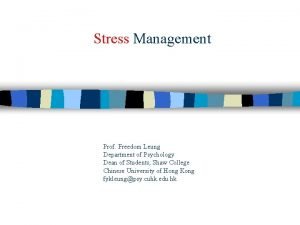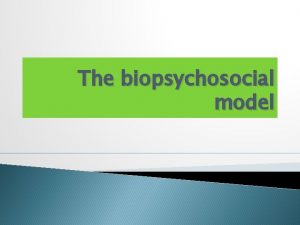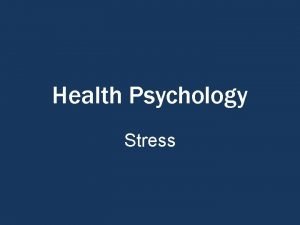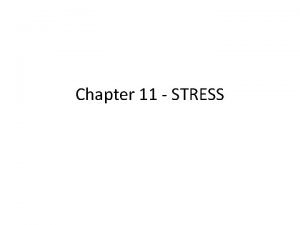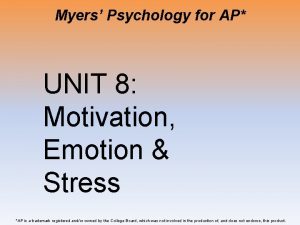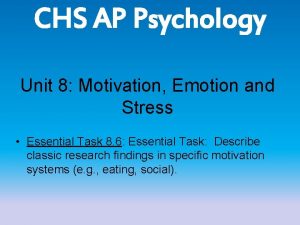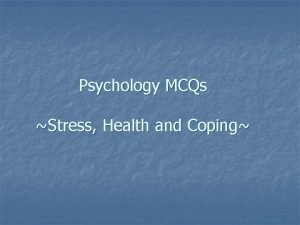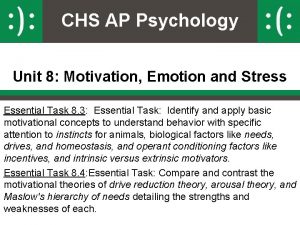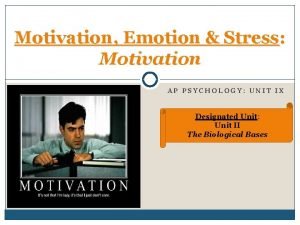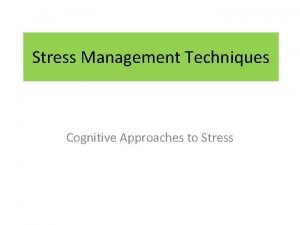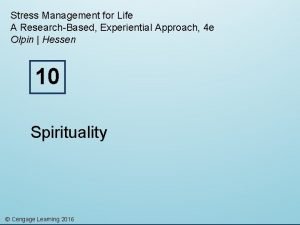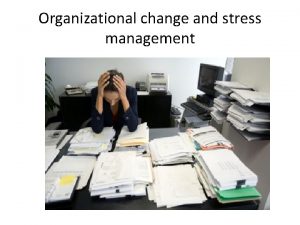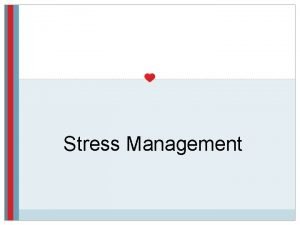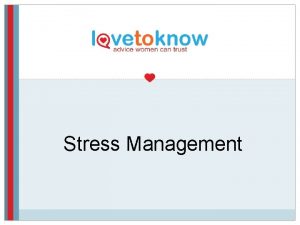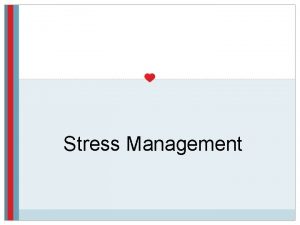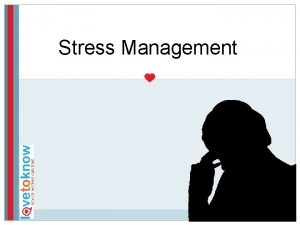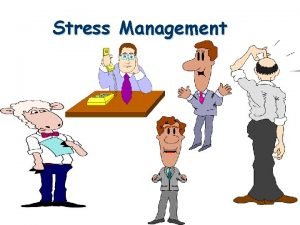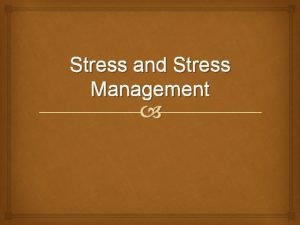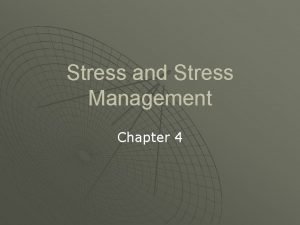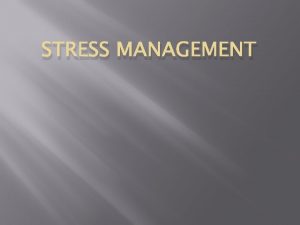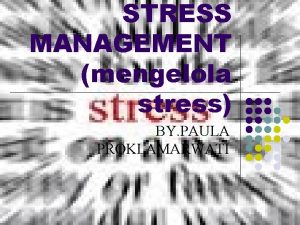Stress Management Prof Freedom Leung Department of Psychology













































- Slides: 45

Stress Management Prof. Freedom Leung Department of Psychology Dean of Students, Shaw College Chinese University of Hong Kong fykleung@psy. cuhk. edu. hk

Learning objectives 1. Understanding Stress Reponses 2. Learning Stress Management Skills

Understanding Stress Responses

How would you feel if you were him?

Activating the acute stress alarm Feeling acute stress Cortex Hippocampus fast affective-bodily reaction route slow cognitive processing route (second alarm) (first alarm) Le. Doux, J. (1996). The Emotional Brain. NY: Simon & Schuster.

Activating the sympathetic responses The acute stress responses n n Adrenal medulla releases adrenaline and noradrenaline Immediately set the body in ‘fightflight’(F/F) alarm mode (pupils dilation, dry mouth, increased heart rate, breathing rate, shut down digestion and sexual activities, strengthen muscular contraction, etc. )

Activating the chronic stress alarm Feeling chronic stress Cortex Hippocampus fast affective-bodily reaction route slow cognitive processing route (second alarm) (first alarm) Le. Doux, J. (1996). The Emotional Brain. NY: Simon & Schuster.

Chronic stress alarm: the HPA-Axis The chronic stress responses n n Adrenal cortex releases cortisol Cortisol breakdowns body fat, proteins, and amino acids into glucose (gluconeogenesis) to guarantee long term supply of energy in our body when stress persists. The Science of Stress Physiology Emotions Fight-flight. You. Tube (2008).

Turning off the stress alarms 2 1

Turn on the parasympathetic system when stress is gone Sympathetic system: stress response s (fight or flight) Parasympathetic system: relaxation response s (rest and digest)

What happen if threat persists? Feeling stress Cortex Hippocampus fast affective-bodily reaction route slow cognitive processing route (second alarm) (first alarm) Le. Doux, J. (1996). The Emotional Brain. NY: Simon & Schuster.

What happen if threat persists? n n n Prolonged stress leads to chronic elevation of cortisol. That results in chronic elevation of blood sugar, blood fatty acid and blood pressure, therefore, increased risks for Type-2 diabetes, cardiovascular and high blood pressure related illnesses. Cortisol breaks down large amino acids into glucose, but amino acids are building blocks of body cells, neurons, neurotransmitters, antibodies and enzymes. Breaking down basic building blocks will lead to their deficiencies.

Biosynthesis of dopamine, norepinephrine and serotonin 酪氨酸 色氨酸

What happen if threat persists? n n Prolonged stress leads to chronic elevation of cortisol. That results in chronic elevation of blood sugar, blood fatty acid and blood pressure, therefore, increased risks for Type-2 diabetes, cardiovascular and high blood pressure related illnesses. Cortisol breaks down large amino acids into glucose, but amino acids are building blocks of body cells, neurons, neurotransmitters, antibodies and enzymes. Breaking down basic building blocks will lead to their deficiencies. Chronic elevation of cortisol also damages neurons in our brain, impairs memory, learning and mood regulation ability.

Elevated cortisol suppresses neurogenesis and shrinks hippocampus Stress, Portrait of a Killer: Full Documentary. You. Tube (2008).

A brain in chronic stress ACC

When AMY is out of control ACC

Body is out of control Sympathetic system: stress response (fight or flight) Parasympathetic system: relaxation response (rest and digest)

Cognition is out of control 1) 2) 3) 4) 5) AMY: affective responses. Hippo: memory biases. ACC: attention biases. VM PFC: interpretation biases. DLPFC: decision & action biases

Summary: the ABC model of stress responses Cognitive reactions 緒 Situation Affective reactions 情 Bodily reactions 身

Learning Stress Management Skills

The ABC model of stress responses Cognitive reactions 緒 Situation Affective reactions 情 Bodily reactions 身

Exercise burns cortisol and calm amygdala

Exercise well Optimal aerobic exercise: 1. 2. 3. 4. 5. burns out excessive stress hormones helps eliminate biochemical metabolites in the body increases oxygen and glucose supply to cells and neurons releases endorphin in our brain which alleviates physical pain and calm negative emotions increases brain-derivedneurotropic-factors (BDNF)

Sleep deficits, elevated cortisol, and hypersensitive amygdala

Functions of sleep : To recuperate and repair 5 sleep cycles (90 -120 mins per cycle)

Sleep well n n n Always sleep sufficient hours (7 -9 hours) according to your individual need Compensate for sleep deficits (naps before 5 pm) Exercise regularly during day time improves sleep quality at night (because exercise burns off excessive cortisol) If you are a sensitive person, avoid caffeine Avoid sleeping pills Sleep and work according to your body clock http: //www. businessinsider. com/what-happens-if-you-dont-get-enough-sleep-2014 -2

Sleep and work according to your body clock

Why should we eat particularly well when under chronic stress? n n Chronic stress results in chronic elevation of cortisol Cortisol breakdown essential amino acids such as tyrosine and tryptophan which are necessary for making important neurotransmitters such as dopamine, norepinephrine, serotonin




Eat well n n n Always eat a balance diet Eat a larger portion of proteins for breakfast Eat a larger portion of carbohydrates for dinner If you are a sensitive person, avoid caffeine (dark tea, coffee, cola, etc) Eat 3 different vegetables plus 2 different fruits per day (for anti-oxidants) Drink 2 - 3 litres of water daily particularly when over-stressed

Interpersonal support calms amygdala

Love releases serotonin and oxytocin

Love well n n n Positive emotional bonding enhances positive emotions, lowers cortisol, enhances immune function, and increases oxytocin, dopamine and serotonin Bond to animals if you can’t bond to people Remember, no drug can replace love!

The ABC model of stress responses Cognitive reactions 緒 Situation Affective reactions 情 Bodily reactions 身


Slow down your breathing can calm your mind: diaphragmatic breathing technique 。。 。 。 。


Stress tense up muscles Sympathetic system: stress response (fight or flight) Parasympathetic system: relaxation response (rest and digest)

Stretching exercises relax body and calm mind

The ABC model of stress responses Cognitive reactions 緒 Situation Affective reactions 情 Bodily reactions 身


Reappraisal of situation “I’m incompetent!” “He has an anger control problem!”
 Freedom leung
Freedom leung Positive freedom negative freedom
Positive freedom negative freedom Glorious freedom wonderful freedom
Glorious freedom wonderful freedom Chapter 10 stress responses and stress management
Chapter 10 stress responses and stress management True strain formula
True strain formula Normal axial stress
Normal axial stress Leung kit wah primary school
Leung kit wah primary school Vinayak nagpal
Vinayak nagpal Leung kit-wah
Leung kit-wah Vivien leung psychologist
Vivien leung psychologist Herbert leung
Herbert leung Debbie leung quantum
Debbie leung quantum Kendrew leung
Kendrew leung Dr janice tung
Dr janice tung Helen leung carefirst
Helen leung carefirst Annabelle leung
Annabelle leung Phillip leung
Phillip leung @netvigator.com
@netvigator.com Ethan li
Ethan li Regine chan
Regine chan Diathesis-stress model psychology example
Diathesis-stress model psychology example Stress definition psychology
Stress definition psychology Selyes general adaptation syndrome
Selyes general adaptation syndrome Diathesis-stress model psychology example
Diathesis-stress model psychology example Ap psychology unit 8 motivation emotion and stress
Ap psychology unit 8 motivation emotion and stress Ap psychology unit 8 motivation emotion and stress
Ap psychology unit 8 motivation emotion and stress Mcqs on stress management
Mcqs on stress management Ap psychology unit 8
Ap psychology unit 8 Ap psychology unit 8 motivation emotion and stress
Ap psychology unit 8 motivation emotion and stress Ucf psychology major requirements
Ucf psychology major requirements Narrativistic
Narrativistic Texas state majors
Texas state majors Syracuse university pool
Syracuse university pool Positive psychology ap psychology definition
Positive psychology ap psychology definition Aggressive role
Aggressive role Fundamental attribution error ap psychology
Fundamental attribution error ap psychology Applied psychology vs psychology
Applied psychology vs psychology Social psychology definition psychology
Social psychology definition psychology Health psychology definition ap psychology
Health psychology definition ap psychology Cognitive stress management techniques
Cognitive stress management techniques Objectives of stress management for students
Objectives of stress management for students Stress management for life
Stress management for life Life skill management
Life skill management Change and stress management
Change and stress management Mental health jeopardy questions and answers
Mental health jeopardy questions and answers Hse stress management standards
Hse stress management standards
